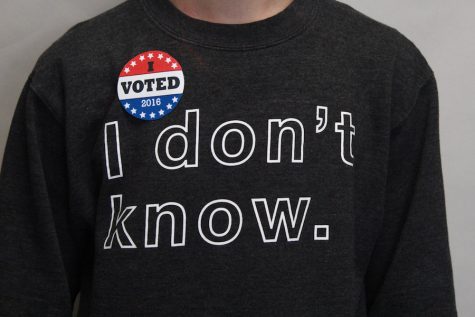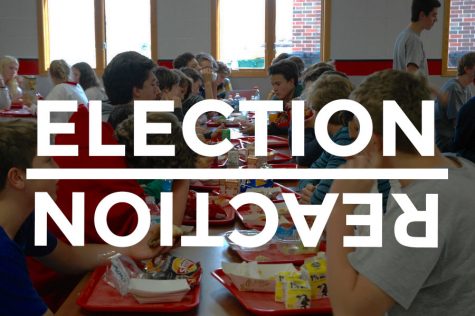BSM post-election cycle: where do we go from here?
The polarization of the 2016 election cycle has brought the constant quarreling of CNN and Fox News directly into the classrooms of BSM. With such diverse ideology, many in the BSM community have been left with the question, "where do we go next?"
January 24, 2017
According to the Young Adult Development Project, a study initiated by the Massachusetts Institute of Technology, the human brain doesn’t reach full maturity until at least the mid-twenties. Specifically, decision making, thought process and emotional regulation are the areas which undergo the highest volume of changes in young adulthood.
Such a development makes young people, especially students, susceptible to the influence of others. Whether it be finding one’s political, religious, or other identities, the process of developing values is undoubtedly clouded by the fact that our brains are vulnerable to the influence of our peers.
In particular, the idea of finding one’s political identity has been a common theme in the past year for students at BSM, especially in light of some of the most polarizing political rhetoric that the United States has ever seen. And, it would be idealistic and naïve to not acknowledge the polarization and divisiveness that’s translated directly from the national stage into the BSM community.
Not only has there been an intense volume of advertisements, debates and campaign speeches, but the pacing of the political season is both quick and constantly evolving, leaving young minds at a loss of how to process such a high volume in such a small amount of time. “The speed at which news items get thrown out there is just so fast, that the knee jerk reaction is also so fast that emotions are also not thought through,” science teacher John Porisch said.
It’s a dilemma that various demographics have grappled with since the presidential election cycle began to heat up: how can we have tough conversations while remaining critical thinkers and being able to think through our actions?
This question has been asked on a national level, but students have visibly wrestled with the issue within BSM as well —without a doubt, many are struggling with the question of where to go and what to do after the division catalyzed by the 2016 Presidential election. It’s no secret that the nearly tangible division of the student body has created an environment that’s arguably less unifying than it’s ever been.
For math teacher and department chair Mary Seppala, consciously creating an atmosphere which focuses on unity begins from the bottom up—which we can’t do without recognizing that relationships become damaged when we define one’s character by their chosen ballot bubbles. “I think students may need to work on rebuilding relationships, and the faculty might need to work on how to build those tough conversations into the classroom in an effective way that’s not going to totally derail everything that they were trying to do,” Seppala said.
The most difficult thing is to approach an argument as something to understand – not something to defend or attack. In short, learn where someone else is coming from.
— Ken Pauly
Although Seppala may not be bringing up controversial issues every day in the math department, she values the importance of learning outside of one’s comfort zone—a feeling found in both a complex math problem and in the real world: “You’re going to be in a workplace with people you don’t agree with… how will you interact with people on hot topic issues and still remain professional, calm, and respectful despite all of the craziness and the feelings of ‘I’m right, how can they not see that?’ When you [students] become adults and go off into the world, stuff like that will come up all the time. How will you interact with people who just can’t see your point of view?” Seppala said.
Like Seppala, AP Government teacher Ken Pauly believes in the intentional integration of current issues into class and does it in a constructive way that doesn’t derail the conversation. Looking to examples set forth by the United States Supreme Court, he sees the idea of interacting with people who don’t understand your point of view as vital to one’s personal growth: “The relationship that existed with Antonin Scalia and Ruth Bader Ginsburg should serve as a guide for all. Brilliant Supreme Court Justices with polar oppositions of political and judicial beliefs, yet, they were dear friends. How was this achieved? They listened to each other and never personalized an issue,” Pauly said.
As someone who facilitates controversial and political conversations daily, Pauly knows firsthand what makes a tough conversation synonymous with a successful one—a feat that has seemed impossible to many in the past few months: “The most difficult thing is to approach an argument as something to understand – not something to defend or attack. In short, learn where someone else is coming from. It doesn’t mean that you need to abandon your belief system or that you are selling out,” Pauly said.
For English teacher Mrs. Leider, difficult conversations can lead back—literally—to page one. “We can have those really tough, hard conversations about things like race and politics, but we can ground it in a piece of literature, which makes all those conversations hypothetical,” Leider said.
Similar to how a new math formula or a new language conjugation can change the way that students learn by pushing them to think outside their comfort zone, Leider uses literature as a backbone to get students thinking about the experiences and hardships of others and why those hardships may exist in the first place. “When you make those questions hypothetical, it challenges kids to think beyond their own personal opinions, and they can then see multiple perspectives through the process of doing that,” Leider said.
The 2016 election made history in a variety of ways: one of which was the first-ever female presidential nominee by a major party convention. Such a nomination brought about discussions about gender equality nationwide, and even in BSM’s very own engineering program thanks to Mrs. Kristin Hoogenakker.
With only 14% of United States engineers being women, there’s a gender imbalance of U.S. engineers—and it’s a gap that Hoogenakker is trying to close, even if it starts in a high school basement. “Changing the gender demographics of engineering takes a cultural shift. Even chatting with some of our female students, snide comments only uttered behind the teachers back are whipped at our ladies questioning their ability and accusing the teachers of going easier on the female students simply because of gender,” Hoogenakker said.
Like Hoogenakker, Spanish teacher Matthew McMerty-Brummer’s intentional integration of cultural competency and an all-inclusive curriculum is a vital part of the classroom. The world language department is a unique environment, though: because some students’ first language is one other than English, there’s a diverse range of ages and grades amongst the class periods.
McMerty-Brummer sees this as an asset to the class dynamic, and, along with Shané Sisco, Joe Creer and Lisa Lenhart-Murphy, has facilitated “affinity groups”—gatherings of students who come together and share a common bond with one another. It’s an opportunity for students, especially those of color, to forge relationships that might not otherwise have been formed. “I think sometimes it seems as though there can be a Red Knight community within the 12th grade, or within the 11th grade, but how often does a freshman have a class with a senior? That’s one of the goals of the affinity groups: to have some senior role models for underclassmen,” McMerty-Brummer said.
In many ways, I think that we are moving into the right direction. However, I feel that we need to be more proactive and intentional and we need to have more discussions.
— Shané Sisco
Mrs. Shané Sisco, a Student Billing Specialist in the finance department, shares much of the same sentiment with McMerty-Brummer: “In many ways, I think that we are moving in the right direction. However, I feel that we need to be more proactive and intentional and we need to have more discussions,” Sisco said.
For Sisco, rebuilding towards unity comes back to the values and beliefs that the BSM community holds and always has held so deeply: “At the moment, we’re focusing on our differences instead of those similarities and bonds which unite us. So, I think it comes down to less politics, and more conversations around compassion for one another,” Sisco said.
For Mrs. Lenhart-Murphy, BSM’s director of mission, some conversations are easier to bring into the classroom using faith as a roadmap. In particular, Lenhart-Murphy highlights the idea that students are some of the most powerful and influential when they bring tough conversations to the table themselves. “The teachings of the church are very explicit—and I think sometimes, people have a hard time taking the teachings and applying them to real world situations. And the thing that I’m proud of with our students is that they do a really good job of making those connections in the classroom,” Lenhart-Murphy said.
One of the most common themes demonstrated through Catholic social teaching is the dignity of the human person, and Lenhart-Murphy sees the principle as one that defies stark party lines. “I think that what’s hard for people, whether you’re a Democrat or Republican, there’s not one party that makes you more Christian or a better person because the issues are so complex, and our focus should be on the Catholic social teachings of the Church—those should be able to lead us and give us the inspiration to deal with the things happening in the political world,” Lenhart-Murphy said.




